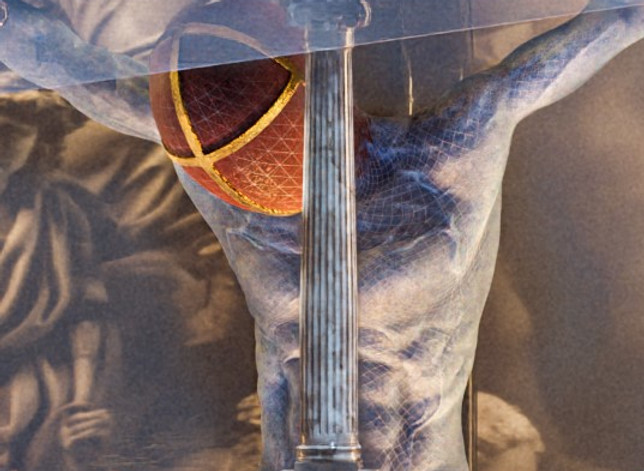

intro
sold-out
The artwork is a combination of two elements, the image above (jpg+tiff 9600x5400px) and a Metaverse Experience where you can actively walk in the artwork and explore it in every aspect with your 3D avatar; please note that the quality of the details in the gallery are considerably reduced compared to the image, for performance reasons. It is advisable to navigate through the Metaverse gallery either before or simultaneously as you keep reading this doc, the read time is estimated to be 10-15 minutes. Get yourself a cup of coffee and let's dive headfirst into this discovery journey.
Link to the metaverse gallery: CLICK HERE
technical details
Resolution: 9600x5400 pixels
Medium: 3D Art
Softwares: Blender + Procreate + Lightroom
Estimated Hours: Around 100h, including the time spent to create the assets used in this artwork

Details and explanations

The Drapery
Guiding the eyes
Taking into account the aforementioned concept, where the museum is perceived as the sanctuary of the artist's soul, the drapery operates as a medium to direct the viewer's attention toward a more profound level of comprehension. Enveloping the majority of the architectural elements, the drapery accentuates solely the artistic components and the artists themselves, depicted through the portrayal of vivid figures in various poses
The Vibrant Figures and the Significance of Their Colors
A symbol to represent a movement
Each figure symbolizes a distinct artist, portrayed not in human form but as a reflection of their inner essence. They are depicted not during the act of creation but through expressive poses that convey their true nature.
In his work "The Spiritual in Art," Wassily Kandinsky conducted an extensive analysis of color's significance in painting. For instance, he noted that blue draws the viewer inward, encouraging deeper exploration, while yellow radiates outward, enveloping its surroundings.
Reading this, around 6 years ago, I considered the connection between our favored colors and Kandinsky's theory about how we perceive them in a painting. This led me to conduct informal experiments over several months by asking friends about their preferred colors and observing their personalities. I found correlations with Kandinsky's observations.
Individuals drawn to blue tended to be introspective, while those favoring yellow were often more extroverted. Kandinsky also suggested that green represents a sense of nobility, denoting a comfort with stillness rather than hastiness.
Additionally, the color wheel implies that a person inclined toward blue may easily transition to yellow under certain conditions, such as the presence of a companion.
The colors and their concept have become a constant in my art ever since.
Thus, it becomes evident that the colors of the figures, in this artwork, represent their personalities.


Their egg-shaped heads, depicted in red, are confined within golden cross-shaped cages. The choice of Red as the color of their heads symbolizes their passion and innate drive to create, with red positioned as the opposite of the still green in the color wheel.
The golden cage that restricts the head signifies the limitations imposed by their human condition, encompassing physical, temporal, and tool-related constraints, along with the complexities of everyday life.
This confinement can overwhelm the artist, gradually transforming their impatient drive, represented by red, into a tranquil green, referred to as 'Ozium' in Latin.
The Artworks on the wall
History in the walls
The artworks adorning the museum have been generated using AI, resenting notable epochs within the Museum's extensive collection. The museum boasts a diverse array of significant cultural artifacts, including captivating displays of Egyptian art, classical Greek sculptures, an impressive coin collection. On one of the side walls, only visible in the Metaverse gallery, there is an homage to Klimt; who painted the roofs of the museum at a young age.
Additionally, exclusive entry to the metaverse gallery is necessary to observe the coat of arms of the Habsburg family, the benefactors responsible for the establishment of the museum in 1891. Notably, it was Habsburg Emperor Franz Joseph of Austria-Hungary who spearheaded the initiative to create the museum to house their extensive art collection

The Wireframe Detail
The hidden structure of existence
In 3D modeling, "wireframe" is a technical term used to describe the mathematical framework of a 3D object. It typically refers to the edge structure of a 3D mesh (object). Building upon this precise definition, I employed the wireframe to convey the concept of the underlying structure. In the upper portion of the image, you can observe the wireframe of the museum enveloping itself. This effect was accomplished by reconstructing the entire museum mesh in 3D and deforming it into a semi-circular shape, creating the illusion of the museum contorting and encircling itself.
A similar wireframe detail is evident in the textures, or 'skin,' of the figures representing the artists. This signifies the profound and interconnected relationship between the artists and the museum itself, as the existence of the museum relies inherently on the presence of these artists. Ultimately, the purpose of the wireframe is to elevate the role of the artists and, by extension, their art as the foundational structure of the institution itself.


The front Figure and the Egg
You're free
Throughout my life, I've regarded Art as the most personal form of expression, employing it as a means of self-exploration and introspection.
In my view, art serves as a gateway to an enigmatic sphere of inner reflection and beauty. Consequently, I hold the belief that certain aspects of artistic creation defy explicit elucidation, as they are intended to be embraced and interpreted individually.
Discover your own meaning within it and make it a part of your own personal narrative.
.jpg)

The inspiration
Wassily Kandinsky once said "Of all the arts, abstract painting is the most difficult. It demands that you know how to draw well, that you have a heightened sensitivity for composition and for colors, and that you be a true poet. This last is essential."
Art, in a broader sense, embodies the manifestation of profound emotional and intellectual sentiments. It serves as a direct reflection of the artist's innermost being, employing structured and recognizable visual elements to convey complex ideas and experiences. In essence, Art is the act of unveiling the artist's inner self.
Guided by this fundamental understanding, the presence of a museum evokes the image of a sanctuary, preserving the eternal essence of countless sensitive souls enshrined within their timeless artistic contributions.







